65th IPC Plenary - Varshets, Bulgaria - Day 2 29th January

9.00 am 29th January 2015
This morning we started with the presentation of the Artistics Committee. Ronald Overdijk opened his presentation by talking about Artistic Events Outdoor and Indoor, he then proceeded to introduce his committee and advisors including Chris Dixon, USA, who will present the "new" indoor discipline of Dynamic.

Ronald directed the delegates to his report in the Agenda Papers and commented on the fact that there had been two FCE events in 2014. The committee had spent more time this year on the Indoor than Outdoor, the Outdoor seems to have been well established now, however Indoor kept them very busy with new developments and discipline changes.
One of the considerations of the committee for Outdoor was to return to gender definition but even though the attendance was higher it was felt that the difference between teams did not warrant change. The two competitions in 2014, the Outdoor event in Prostejov was well attended, a higher attendance than previous years which was encouraging, but the attendance at the Indoor event in the USA was disappointing. This, it was felt, was due to the format (which will be covered in the new proposals) as well as the costs.
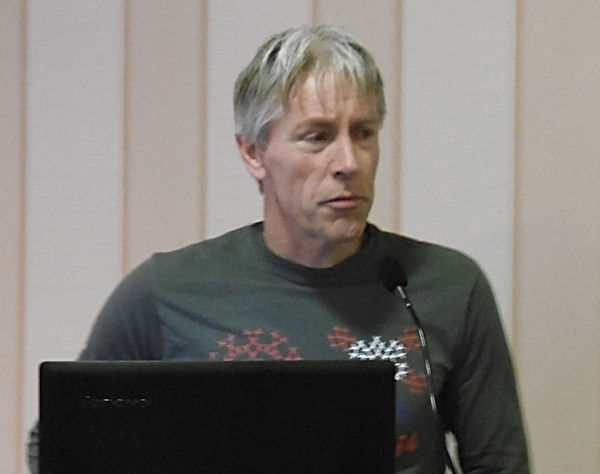
It is proposed to change the Freefly element to Dynamic - 2-way and 4-way for Indoor events. There were also plans to work on the judging criteria. The committee is proposing to allow music for teams during an Indoor event. It is also proposed to move to live judging for Indoor events which removes problems with the camera angle. The number of judges for Indoor will be set at 4 judges + a Chief Judge who can also act as an Event Judge. The committee will work with the Formation Skydiving committee to agree the number of teams for entry for Indoor events.
The committee would also like to lower the sanction fees for all Indoor events, as there are fewer judges needed and therefore the costs of the competition are less. The committee will work with the Financial Secretary to agree an amount, but they would like to see it in the region of 40-45 euros. With the number of Windtunnels increasing it will be easier to run Continental Championships and the committee looked forward to bids from regions other than Europe to host such a championship.
 | 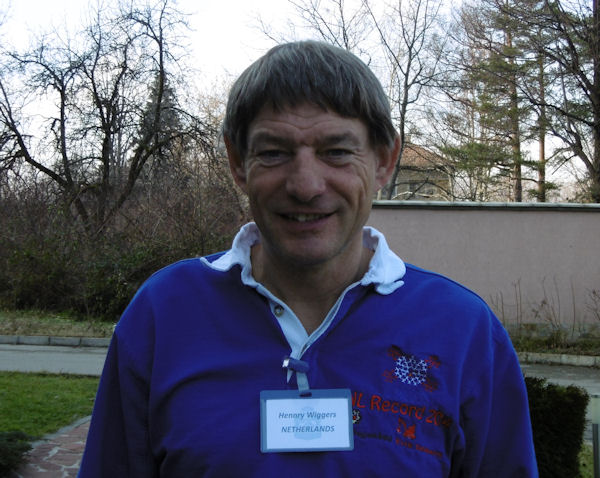 |
| Chris Dixon | Henny Wiggers |
Chris Dixon then made a interesting presentation on the proposed new Dynamic discipline explaining from the competitors point of view regarding the existing Freefly event and to move this event forward into Dynamic. He then moved to the competition format which is a battle format, exciting and very audience (and competitor) friendly.
Ronald then called Henny Wiggers to present the Netherland's bid for an Outdoor Artistics FCE in 2015. The only questions from the floor related to the cost of the 3rd party Insurance to those competitors who do not have it. Ronald Overdijk undertook to look into it, but he did not think it would be possible to change.
Ronald then announced his resignation as the Chair of the Artistics Committee which he has held for 21 years and seen the establishment of his discipline. It is now time for new blood, he will remain on the committee, but now wishes to step down. He announced that the deputy chair Ron Miasnikov is willing to take over.
10.00 am: 29th January 2014
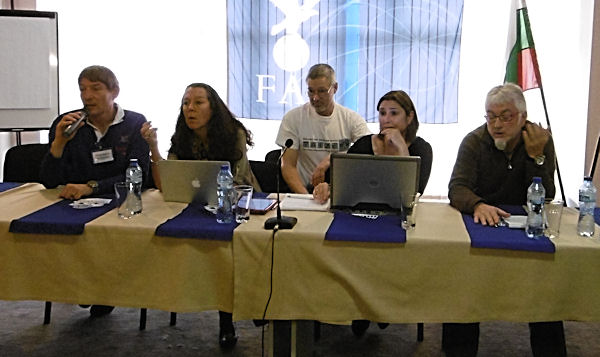
The second presentation was made by the Canopy Formations Committee. Rina Gallo, Deputy Chair of the committee, presented the report with apologies as she only learnt at the very last minute that the Chair of the committee, Lindy Rochow-Williams, Australia, was unable to attend.
 |
| Marylou Laughlin and Rina Gallo finalising a few points. |
Rina spoke in general terms about the discussion the committee has had with some points; the hook grip definition, defining the result in a tie-break situation relating to the discarded rounds, hook grips definition and the omission definition and scoring. She appealed to organisers to come forward to host a future event, and looked forward to the next World Championships which will take place durng the Mondial in Chicago, USA, 2016. The committee will also consider the request from competitors to set some CF records.
Bernard Nicholas then presented an extension to his report from the World Championships 2014 in Banja Luka. He started by thanking the FAI Controller for his help and support during the competition to ensure that the CF continued alongside Style and Accuracy. He also explained how he had briefed the camera flyers with a short video showing good, bad and questionable (could results in busts) video judging evidence. This was very well received by the camera flyers and he also thanked the Judging panel he worked with for their contribution.
 |
Bernard Nicolas |
Rina then tried to close the presentation from the committee, but Buzz challenged her from the floor to present the actual changes the committee was proposing for discussion - that was the point of the open meeting before the Plenary. Rina and the committee then presented the discussion and decisions they had made on the items mentioned earlier and there was a lively discussion from the floor. The most contentious issue being how to comply with the rule relating to working after the end of working time - this did cause considerable discussion and the committee agreed to go back and come up with a firm proposal for the Plenary.
We then moved on to the presentation by Trude Sviggum and the Formation Skydiving Committee.
 | 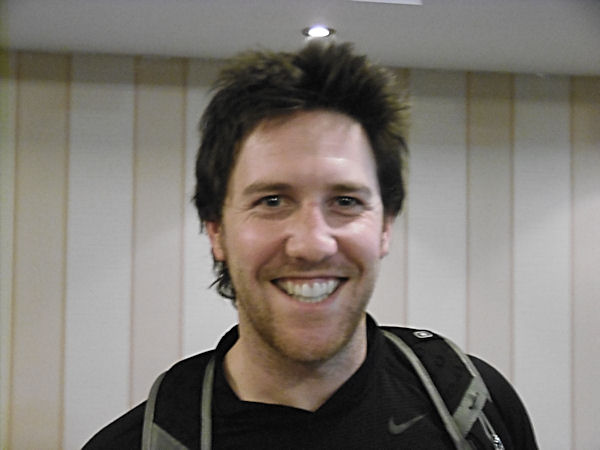 |
| Trude Sviggum | Martin Lemay |
Trude welcomed Martin Lemay onto the committee and also Anne Mine Moeller Petersen of Denmark and Dr. Rainer "Exi" Hoenle is standing down from the committee on the grounds that "younger people may step up" and Trude states this leaves a place on the committee for another member and she would like to see a Judge fill this role.
Trude then moved on to the competitions in 2014. She stated that the attendance at Prostejov was average but as had already been stated, the attendance at the 1st World Cup in Indoor Skydiving was disappointing for the reasons already stated.
She then moved to the minor proposed changes to the existing rules. Firstly they would like to combine the Competition Rules for FS and VFS and move away from the two sets of rules. VFS Block 4 is incorrect and will be corrected in the dive pool. They will change the wording on the camera location in the indoor rules, by not defining its position, but just that all team members are clearly visible.
There had been a request to look at Block 10 and this had been discussed by the committee but they decided not to change this block at this time. The other proposal to change the number of alternates from 1 to 2 for 8-way. The committee was neither for nor against and it was put to the floor – but there was no interest from the floor to make the change. The committee was against it also. The further proposal was to increase the number of rounds for VFS to 10 rounds. The committee did not support this proposal either as they felt VFS was a difficult enough discipline without making it more so.
Trude then gave the floor to Kirk Verner, USA, to present their proposal for a new discipline of 2-way mixed formation skydiving. The intention was to have a competition that allowed the development of teams towards VFS. It was discussed at length by the delegates and Kirk answered all questions, but the general feeling from the floor and the committee was not to support this proposal.
Ron Miasnikov, Israel, then presented her proposal to include the 4-Way Female event into the Open event, but to keep the medal awards for the top female teams. In the same way that a World Cup and European Championships were. Again this led to discussion from the floor, but the message to the committee was that this is not supported.
By now it was time for a coffee break, short meetings and networking.
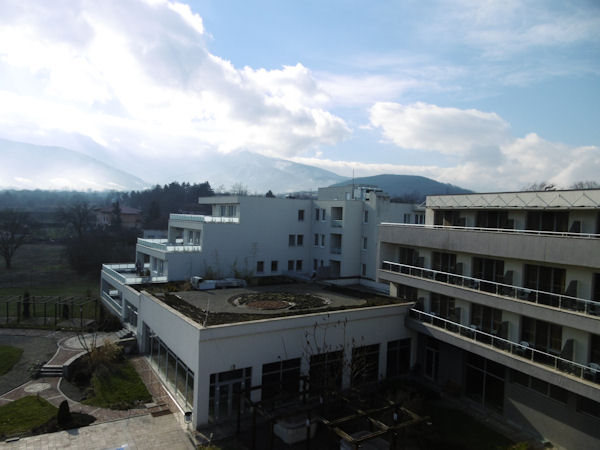 |  | 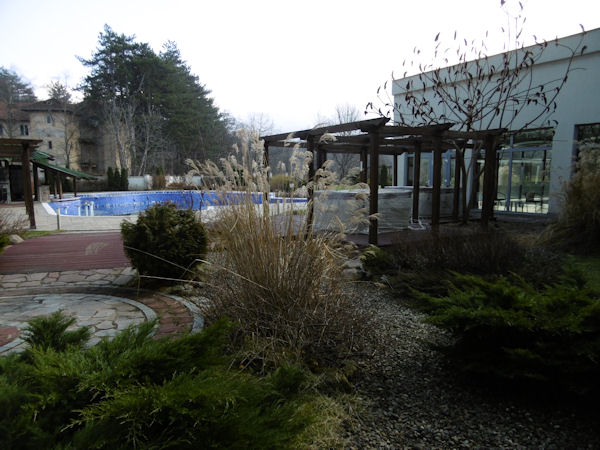 |
| The sun came out today, but as it's late January, no one took advantage of the outdoor pool or hot tubs! | ||
After coffee
11.30 am: 29th January 2015
Speed Skydiving was presented by the chair, Elisabet Mikaelsson who welcomed her committee members Arnold Hohenegger and Johannes Gritsch and announced that Kate Charters, UK would be joining the committee. Two other committee members Michael Lovemore and Thomas Moritz Friess were not able to attend. The first World Cup was well supported, but all the competitors were from Europe, however the committee believes that the next competition will bring in USA and Australian competitors
 |  |
| Elisabet Mikaelsson | Arnold Hohenegger and Johannes Gritsch |
.
The committee had looked at the speed measuring devices they used and an alternative to the Protrack system is still under test. They have also been working on updating the software of the analysis system and this was completed and tested at the competition in the 5th DIPC in Dubai 2014. The committee would like to ask the Judges Committee to approve this as an Approved Judging System.
As a committee they also wished to be able to have a public display and Elisabet showed a short video to demonstrate what could be done. She then moved to the Competition Rule changes which were mainly housekeeping and the one main proposal was how to calculate and penalise the Out of Bounds rule, and had decided to go with progressive penalties. This will be presented to the Plenary for verification. There was a small amount of discussion from the floor, more of a clarification nature then disagreement.
Before the break for lunch at 13.00 we continued with Indoor Skydiving Working Group
 | |
As Gillian Rayner explained this group no longer formally existed as it was a temporary Working Group which no longer worked after the acceptance of the discipline and the first set of Competition Rules. She thanked both Trude Sviggum and Ron Miasnikov for their contributions and welcomed Chris Dixon and the Dynamic contribution. Gillian proposed that a new committee is formed for Indoor Skydiving – it could stay small and should include representatives from the Formation Skydiving and Artistic Events Committees and a chair to liaise with the Bureau.
Gillian then referred to the interest and support for Indoor Skydiving showed by Markus (FAI) and Bushman (IPETA) that this is a real way forward for our sport. Competitors want to have the titles and medals, of approved FAI sanctioned and recognised competitions.
There then developed a discussion with input from the floor on the Junior category, age and the requirements of the Child Protection Legislation. This is a subject that the committee is aware of and will take advice and input.
There are bids on the table for 2015 and 2016 from the Czech Republic and Jiri Blaska and his daughter Sarka presented these and answered questions from the floor. The bids have been accepted by the committee who would like to propose an alteration to the year of World Championships for Indoor to the “off” year and World Cups on the “even” year. Trude seconded this by saying that teams in training would use the Indoor competition as a training for the following year’s World Championships.
Gill then gave the floor to John Smyth, UK, to make his presentation with the problems the UK have with accepting Indoor Skydiving and asked for help from those delegates who had managed within their countries to come together with their tunnel operators and the different problems of organisation this presents to the NAC involved. Their questions and problems were also reflected by the USA who also would like to find a solution.
It was interesting that the 1st World Cup in Indoor Skydiving was hosted by a Tunnel in the USA – but their bid was not officially supported by the NAC, but a way round was found, and although it had not been well attended for a variety of reasons had been as success.
The Judges Committee then made their presentation under the leadership of the Chair – Pia Beggren.
She commenced the presentation by informing Delegates that the Nominated FAI Judges List was on display outside the meeting room, and asked that they be checked. Any changes or questions should be directed to Rina Gallo. She then proceeded to talk about the scoring systems and the fact that up until now it has not been possible to use the digital material produced by one system (CF, FS and AE) on the other. Now they are both working to produce the digital material in mp4 format which makes the creation of judging tapes for training much easier. In addition she mentioned the problem of where a CJ responsibility ends with the result production, if they have checked input they have to rely on the systems internal calculations working correctly. It is partly for this reason that the committee asks that a reasonable time frame be allowed in order to approve a new system – not 2 months before a FCE.
Pia then moved on to some rule changes that clarify existing rules, and are simply a question of rewording, however a new proposal to restrict the use of additional judges at a FCE to a role that would not replace a selected judge caused considerable discussion from the floor; the committee undertook to look at this again. The committee had also taken note of the potential new disciplines and those approved last year to establish training programmes and requirements for these going forward.
The committee set a deadline of the 20th February 2015 for the NAC’s to return the lists of available judges for the Competitions 2015 agreed at the Plenary.
Pia then moved on to the On-Line Judge Training and Judge Training support and material. A lot of work had been done during 2014 to bring the on line training course up to date with new discipline specific presentations covering, Accuracy Landings, Freefall Style, Canopy Formations, Formation Skydiving, Artistic Events and including the Sporting Code and Section 5, the Qualities of a Judge and work continues on CP and Camera work. Pia made a point of thanking Elisabet Mikaelsson for all the work she had done in starting the on-line system. It was not until the work was taken on by Karla Cole as Judge Training Co-ordinator did the amount of work become apparent. The courses now running on the site were the work of many people including the Judges Committee, members of the judging community and the discipline committees. There was more to be done, obviously to update with any rule changes – and new disciplines – plus a narration for each course done by a native English speaker. Work will also continue on the quizzes and the videos available on the on-line course to demonstrate different judging questions and areas to look for. A link will also go on the site to the various web-sites and YouTube channel where videos from competitions may be accessed.
In addition to all this, new training course exams have been standardised so that any approved Chief of Judge Training can deliver a course and the training judge, wherever they are in the world will sit the same exam and be evaluated against a video compilation of approved scores. All the material to run this course will be hosted on the new Virtual Server offered by the FAI for IPC’s use.
At 15.00 hrs 29th January 2015 Buzz Bennett, Canada, and his Rules and Regulations committee took up their place on the top table.
Working through proposed rule changes to Section 5 the first were merely housekeeping ones to correct errors from previous years (they are in the Agenda papers), but when Buzz got to the proposal to reverse a decision of last year’s Plenary did the first of the big discussion take place. This related to the process of starting a Protest at a competition and the time-frame to work in. The current wording was a result of a proposal put to the Plenary last year by Alberto Martin Paracuellos, Spain and he objected to the proposed reversal on the basis that something approved by the Plenary should not be disregarded. It was quite a heated discussion and in the end Buzz said the committee would consider it again. Buzz then moved on to other less contentious proposed changes and accepted proposed word changes from the floor. We then covered proposals to changes caused by the decision of the CASI (FAI) to tidy up the General Section of the Sporting Code and those sections that were taken out to be returned to the Air Sports Commissions to include in their own Sporting Code. In the case of Parachuting this is Sporting Code Section 5.
The elimination of the need to issue Diplomas to competitors placed 1-10 at the end of a competition, and so only medals for the first 3 places will be issued. Finally there is agreement that a Competition Record broken at a FCE could be submitted by the Chief Judge and the NAC hosting the event without going through the complex record submission process in place today. Buzz thanked Gillian Rayner for all her work on the General Section.
The proposed changes relating to refunds to NAC's in the case of concellation of a competitoin, prior to, or after the start of a competition due to Force Majure and the withdrawal of a NAC from a FCE - this is detailed in the agenda papers. There was a lot of discussion as to the detail and how it should be arrived at. This will be formally presented at the Plenary taking account of the comments made.#
The New general Section is now completed and Air Sports Commission can decide when to make it “official” within their organisation – with a deadline of 1.1.2016 as the ultimate target. The proposal of the committee was that this is adopted in line with all our documents, i.e. Section 5 and Competition Rules by the end March 2016.
Exi then made a proposal that the ability to have a Bulletin modified excludes the ability to change the start and stop times, as this could lead to problems for the organiser.
The discussions had been quite long and it was now 16.30 – Graeme suggested a coffee break until 17.90 when the committee could finish their presentation.
17.00 29th January 2015 : Rules and Regulations continues
The second session started with a proposal from Gernot Rittonschober, CISM that the ‘Clause 1.1.4 Identity’ in section 5 be removed completely and the responsivity for ensuring that the spirit of this clause is not abused by place on the Chief Judge. Again there was general discussion from the floor and Buzz agreed to add this to the changes and put it to the vote at the Plenary.
The next proposal for change to ensure that Nominations for the Bureau members be notified in advance to the recording secretary for inclusion in the meeting agenda, accompanied by a CV. A second part of the proposal was that proxy votes for elections could not be accepted unless pre-notified to the FAI and the name of the nominated person be stated. This was another proposal that generated a lot of discussion from the floor with strongly held views expressed to remain as is currently and to make the change. The committee will take this on board and put together a proposal for the Plenary. The other proposed changes – mainly housekeeping - did not cause discussion on any large scale or questions from the floor and so the meeting drew to an end.
Delegates left the meeting room to continue their work in smaller groups. The committees now have tomorrow to finalise their papers for submission to the Plenary and voting.
